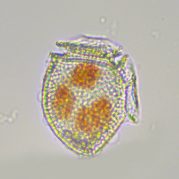Harmful Algal Bloom (HAB) Species
Phytoplankton organisms such as photosynthetic microalgae and cyanobacteria play a critically important role in the ecology of marine and freshwater ecosystems. In addition to comprising the foundation of aquatic food webs, they fix carbon and control carbon dioxide levels in the earth's atmosphere, and produce roughly half of the world's oxygen through photosynthesis. However, a subset of these organisms cause problems when accumulate in high concentrations, or form "blooms". These particular species can cause harm due to their ability to produce potent toxins, or through impacts associated with their sheer biomass. These species are known as harmful algal bloom species, or HABs.
Only a few dozen of the many thousands of species of microscopic and macroscopic algae are repeatedly associated with toxic or harmful blooms. Some species, such as the dinoflagellate Alexandrium catenella and the diatom Pseudo-nitzschia australis, produce potent toxins that are concentrated in fish or shellfish. Toxic effects can also be associated with inhalation of aerosolized toxins, or by swimming in toxin-contaminated water.
Other species do not produce toxins but cause other harmful effects. For example, certain Chaetoceros diatom species have spines with serrated edges, which can lodge in fish gill tissues, causing irritation. For other species such as Margalefidinium polykrikoides and Heterosigma akashiwo, harmful impacts are associated with high biomass, but the mechanisms of toxicity are not fully known. In the U.S., freshwater HABs have been reported in every state, and marine HABs have been reported in every U.S. coastal state. In many regions of the world, the occurrence of HABs may be on the rise, driven by environmental changes such as warming ocean temperatures and increased nutrient inputs, as well as expanding aquaculture and fish farms. HABs are a national concern because they affect not only the health of people and marine ecosystems, but also impact local and regional economies. As the prevalence of HABs and their impacts are different in different regions, each of these harmful species require careful study at both the organismal level and within systems if we are to understand and mitigate impacts of HABs throughout the U.S.
Below are links to overview information about HAB species, the syndromes they cause, where they are found, and information regarding the life cycle dynamics of two prominent and widespread marine HAB groups (Alexandrium spp. and Pseudo-nitzchia spp.) and one group found in freshwater systems (Nostoc spp.).

